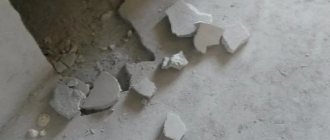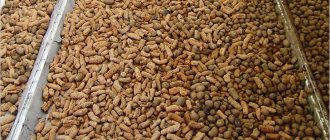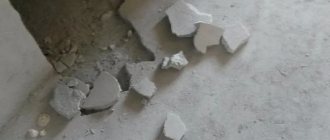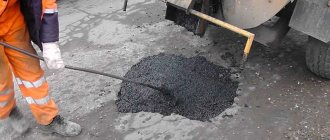In today’s article we’ll talk about cracks that occur due to improper manufacturing and storage of concrete products. We'll tell you what they are, why they appear, and what to do to avoid them.
— Types of cracks according to the degree of influence on the structure — Types of cracks according to the reasons for their formation — Shrinkage cracks — Temperature cracks — Cracks during manufacturing, transportation, storage and installation — Methods for preventing the appearance of cracks — What to do if cracks appear in the structure?
| But first, an interesting offer! You can try our own ST RA-50 mold and formwork lubricant for free. It provides an improvement in the surface of the product, easy separation of the product from the mold, an increase in the service life of the formwork and faster removal of formwork. To receive it, you must submit a request by clicking the button below. Our technologist will contact you and agree on a convenient time! Try ST RA-50 lubricant for free! |
Technological cracks
- these are cracks associated with the manufacture, process of strengthening, transportation or storage of concrete products.
Classification of concrete damage
As a result of various internal and external influences (see Table 1), concrete can crack. This applies to large and small objects stressed by external loads or under tension from their own weight. To understand why concrete cracks after pouring, you first need to know the classification of cracks.
Spalling and cracks in concrete vary:
- by nature – through and superficial (deep and shallow). To determine the depth, various types of probes and ultrasonic devices are used;
- in width – microscopic (hair-like), medium (over 1 mm), wide, massive (more than 10 mm). To determine the width of cracks, measuring instruments of varying accuracy and nature are used;
- by exposure of reinforcing elements - promoting corrosion (up to the reinforcement, with its complete or partial exposure) and passing between the reinforcement elements (along the edges, in the spaces);
- by time of formation - primary (during the process of hydration, shrinkage of the concrete mixture) and secondary (during the operation of the structure);
- by location - at the corners and edges of a concrete object, over the entire surface, throughout the entire volume, local (for example, in the area of applied stress or periodic mechanical influences);
- according to the degree of impact on the structure - reducing strength (5...50%), destroying (reduction in strength over 50%).
Important: if the expected concreting and operating conditions are violated, the occurrence of cracks is inevitable, therefore a margin of 10...30% is included in the design conditions.
Shrinkage of hardening concrete
Shrinkage of hardening concrete occurs during the period of concrete structure formation (in young concrete) due to contraction shrinkage.
The shrinkage of hardening concrete is essentially the shrinkage of cement stone. It begins after several hours of early hardening. A very significant part of contraction shrinkage develops when concrete is young (approximately within 7-10 days). Almost all shrinkage of hardening concrete ends by 28 days, when the concrete reaches grade strength.
Contraction shrinkage
Contraction shrinkage (chemical shrinkage, chemical shrinkage, autogenous shrinkage) is shrinkage as a result of chemical processes of interaction of starting materials occurring in the cement stone. Occurs due to the fact that Portland cement interacts with water (this phenomenon is called hydration).
Cement hydration is a chemical reaction of cement with water to form crystalline hydrates. During the process of hydration, liquid or plastic cement glue (cement + water) turns into cement stone. The first stage of this process is called thickening or setting, the second is called hardening or hardening.
Due to hydration, the new substances formed (cement stone) are less in volume than the original volumes of Portland cement and water combined (cement paste). This decrease in volume leads to the appearance of so-called contraction porosity in the concrete structure, which has a positive effect on the frost resistance of concrete and contraction shrinkage appears, a negative property of concrete.
This happens as follows:
When cement is mixed with water, a loose mass is formed from the surface layers of cement grains - a colloid, the so-called gel, which glues cement grains or grains of sand and crushed stone. With the formation of a gel, the cement paste begins to thicken and lose its plasticity. This process is called setting.
Simultaneously with hardening, the gel mass becomes denser. The amount of water in the gel decreases, and when hardening in air, the evaporation of water from the surface of the body significantly affects the hardening process, accelerating it in those layers that are located closer to the outer surface of the structure.
But the main reason for the decrease in water in the gel, accompanied by its hardening, is not drying or evaporation, but the so-called “internal suction”. This means that the still undecomposed grains of cement gradually begin to hydrate and, by sucking water from the previously formed gel, form new masses of gel. Thus, the gel colloid is gradually dehydrated, compressed, hardens and, like ordinary wood glue, significantly decreases in volume and turns into a solid body with significant strength - into cement stone.
This decrease in volume, called the “actual shrinkage of concrete,” is an inevitable concomitant of cement hardening, regardless of whether the concrete hardens in air or in water.
The suction of water from the surrounding gel continues until the cement grains are completely reacted. In cement, grinding is not very fine; this requires decades, and due to this, concrete shrinkage takes a long time.
How to avoid shrinkage of cement stone?
It is impossible to completely avoid shrinkage of cement stone, since the hydration products are less than the volume of the original materials. The only exceptions are shrinkage and expansion cements.
The linear change in dimensions during contraction shrinkage is 1 mm per 1 m and is usually not taken into account in the construction of low-rise buildings.
Causes of cracks
Repairing cracks in concrete depends to a large extent on the cause of the crack, its nature and location. Therefore, first of all, it is necessary to understand the cause of the phenomenon and the characteristics of the manifestations of specific types of cracks.
Table 1. Causes of concrete cracks
| Cause of occurrence | Process Features | External signs | Appearance period | Possibilities and methods of prevention |
| Shrinkage of fresh mixture during concreting | Dehydration too quickly (high or low temperature, dry air) | The cracks are located above the upper reinforcement, the depth is insignificant, the width depends on the degree of dehydration | While the concrete retains its plasticity (1…3 hours) | Careful attention to the percentage composition of the solution, vibrating, vibrating again until it sets |
| Early plastic shrinkage | Compression of dried surface layers of concrete against the resistance of a wet core | Minor depth, width more than 1 mm, location without pronounced directionality | While maintaining plasticity | Repeated vibration, protection from premature drying (moisturizing, covering with film) |
| Heat release during hydration | During massive concreting, the hydration of the core heats the inner layers, while the outer ones cool at this time. The temperature difference causes an increase in stress (compressive in the center, tensile at the edges) | Through and surface cracks, at bends, width up to or more than 1 mm | The first days after concreting, depending on the rate of hydration and external conditions | Attention to the percentage composition of concrete, cooling of massive concreting, creation of expansion joints |
| Shrinkage as it dries | The emergence of tension as a result of a decrease in the volume of the finally dried mixture | Cracks of any nature, depending on the geometry of the massif, over 1 mm | After final curing, 2….20 weeks after concreting and later | Strengthening reinforcement, selecting concrete composition, making expansion joints |
| Deformation due to temperature changes | If there is a sudden or prolonged change in temperature outside the design range | Usually through and at a bend, less often superficial damage, width more than 1 mm | Any time | Increasing the design temperature range when selecting a mixture, strengthening reinforcement, expansion joints |
| Mechanical deformation | Occur as a result of changes in the position of supports | Any character, most often through and on bends, more than 1 mm | Any time | Prestressing of reinforcement and its strengthening, selection of mixture, installation of expansion joints |
| Self-voltage | Incorrectly selected position and tension of the reinforcement, mixture composition | Any | When voltage occurs | Correct reinforcement |
| External load | With increased or directed external loads different from the calculated ones | Damage in bending, shear, surface and through microcracks | When applying load | Correct reinforcement, calculation accuracy |
| Frost cracking | For mass or local cooling outside the design temperature range | Damage occurs along the reinforcement, in voids (especially wet or filled with water) | In moments of cooling | Vibration compaction of concrete during placement to prevent voids, prevention of intentional damage |
| Corrosion processes in fittings | Changes in stress in the mass due to moisture access to the reinforcement and insufficient protective layer of concrete | At the corners of building elements, along reinforcing parts | In 3…10 years | Compliance with the rules regarding the protective layer of the concrete mixture, no access of atmospheric or ground moisture to the reinforcing elements |
Types of cracks in concrete monoliths and foundations
Cracks in a monolith can have different sizes, depths, shapes and origins. They have typical features, and building codes determine the permissible opening width - the distance between the edges in the area of maximum divergence. For structures described in SP 28.13330, the presence of cracks is considered a critical defect, but this applies to particularly critical projects where the monolith will be under pressure and exposed to liquid or gas.
The norms of SP 63.13330, which apply to the construction of low-rise residential buildings and the creation of foundations for cottages, are somewhat softer. Therefore, in some cases, the appearance of cracks is not considered a critical situation:
- superficial hairy up to 0.1 mm, not penetrating into the thickness of the monolith;
- shrinkage up to 0.3 mm for low-critical structures or foundations of low-rise buildings;
- horizontal up to 0.3 mm - pose a danger to heavy structures if they pass through the entire monolith;
- combined, caused by delamination of reinforcement - the situation is considered individually, but for critical loaded parts, the appearance of such cracks is absolutely critical.
The appearance of the first two cracks can be prevented even at the stage of design and preparation of technical specifications - when carrying out concrete preparation, it is enough to use B7.5 class concrete as a compaction on loose and heaving soils to reduce the risk of displacement of parts of the base. The price of this mixture is low, only a small quantity is needed, but the effect of compensating the deforming force will be good.
Shrinkage cracks
The insidiousness of shrinkage cracks is that they can appear much later, when the problem is no longer a violation of the water-cement ratio and the initial subsidence of the soil under the weight of the mortar. If such damage occurs after several months, then it is necessary to examine it in depth. Surface cracks can be repaired with special repair solutions.
Load cracks
Other dangerous damage to the monolith in the form of cracking occurs due to the distribution of loads in the thickness of the solid mixture.
An example is a joint crack that runs along the lines of reinforcement bars in places of complex joints. It can appear from early loading of the base, soil displacement during freezing, or the use of small-section reinforcement. Most likely, the protective layer will move away from the reinforcement, which will reduce the strength of the structure due to heterogeneity.
Through cracking of the monolith - a tension has occurred that passes outside the center of the monolith along the reinforcement.
Shear - a crack will pass diagonally to the reinforcement bars; its origin is associated with loading until strength is gained in the transverse plane.
Bend - the crack will run perpendicular to the axis of the wall, its beginning will indicate the boundary of the tensile zone.
Cracks appearing on the surface may indicate that the reinforcement was rusty at the time of pouring, and the corrosive layer has moved away from the metal.
A vertical crack that is discovered in the spring, after the first winter season, indicates that the geology and soils were not studied or taken into account at all, and no calculations were carried out. The probability of structural failure is high.
Ways to prevent cracking of concrete are to adhere to pouring technology and temperature conditions in winter and in hot weather. Cracks can be eliminated in the first one and a half to two hours (from preparing the mixture at RBU!) by repeated vibratory laying, and then by using special repair solutions.
Protection and prevention during concreting, means and methods
To prevent concrete from cracking, the hardening mixture must be protected from external influences until it is completely cured and reaches brand strength. For this, experts recommend:
- make plastic shrinkage of the mixture minimal;
- ensure the absence of impacts that reduce the strength and durability of the composition.
At the same time, according to regulatory documents, acceptable dates for starting work on concrete objects are those at which 100% brand strength is achieved, and removal of the formwork is expected after reaching 70% readiness of the composition.
Measures to reduce plastic shrinkage of concrete
- careful selection of the percentage composition of the mixture, taking into account operating conditions;
- vibration compaction, including repeated compaction if necessary. Preference should be given to the machine version, since manual does not provide the necessary guarantee of the absence of cavities and the correct distribution of volume throughout the formwork space.
Care of concrete during the curing process
To avoid the problem of “concrete cracking as it dries,” it is also important to take care of the mixture during the curing process.
- Protection of concrete outdoors from excessive dryness and wind, daily and long-term temperature changes. To do this, depending on the air temperature, measures such as covering with film, moistening the concrete and formwork, maintaining a thin layer of water on top of the poured mixture, and thermal insulation of the mass are used.
- Protection of concrete from destruction (mechanical and chemical damage) until it reaches its design strength. For this purpose, the formwork can be covered on top with shields over film or thermal insulation.
Polymer coatings for concrete during the curing process (film) are laid, whenever possible, as a single piece or with pieces overlapping at least 30 cm and the seams are taped.
Cracks in floor slabs and precast floor panels
The nature of cracking in slabs and panels is presented in Figure 6.9.
Figure 6.9 – Typical “power” cracks on the ceiling surface of slabs loaded with a uniformly distributed load ( a – f, h
) and concentrated (
g
) loads:
A
– working according to a beam scheme with
l
1/
l
2 ≥ 3;
b
– supported along the contour at 2 1.5;
h
– the same for
l
3/
l
1 ≤ 1.5
Floors of industrial enterprises operate in difficult conditions, experiencing technological overloads, shock and vibration, the destructive influence of technical fluids and other aggressive environments, which leads to their rapid wear and, consequently, the appearance of cracks. Floor slabs with different aspect ratios are characterized by the development of force cracks on the lower tensile surface of the slabs (see Figure 6.9). In this case, the concrete of the compressed zone may not be damaged. Concrete collapse of the compressed zone indicates the danger of complete destruction of the slab. As can be seen from Figure 6.9, the nature of cracks caused by force depends on the static design of the floor slab: the nature of the acting load, the method of reinforcement and the ratio of spans. In this case, the cracks are located perpendicular to the main tensile stresses. The reasons for the wide opening of “power” cracks are usually overloading the slab, insufficient amount of working reinforcement or its incorrect placement (displacement towards the neutral axis).
One of the most commonly used reinforced concrete elements is PC-type hollow core floor slabs.
Typical cracks in hollow-core floor panels are shown in Figure 6.10.
Figure 6.10 – Force and technological cracks in a hollow-core floor panel:
1 – normal; 2 – inclined; 3 – inclined, caused by pinching of the longitudinal section of the panel; 4 – longitudinal, caused by concrete thawing at the locations of the punch holes; 5 – longitudinal, caused by corrosion of reinforcement; 6 – technological in the ribs between the voids, formed when pulling out the punches and longitudinal cracks in the top flange along the punch holes
Strength cracks 1 in hollow-core panels indicate insufficient strength along the normal section.
If the concrete is cracked
When cracks of any nature appear on the concrete mass, it is necessary to monitor the process and, if possible, stop it. At the stage of curing the mixture, this can be timely moistening or protection from the wind. Termination of the process will significantly reduce the problems of repairing cracks in concrete and will preserve the functionality of the structure.
If cracks are detected in a structure that has been in operation for a long time, you should:
- conduct an inspection of all parts of the building (structure) to determine the distribution of cracks. This will allow you to determine the cause of cracking;
- identify the nature of the detected damage (superficial or through, extensive or microscopic, with or without exposed reinforcement);
- determine the opening width of cracks in concrete and their geometry (the degree of narrowing as they go deeper into the mass, tortuosity, etc.).
It is necessary to decide on a repair composition for sealing cracks in concrete after determining the nature and extent of damage, and also depending on the time of occurrence of damage.
The cracks appeared before hardening - it is necessary to arrange additional vibration compaction, two or more times, until the cavities are eliminated. If cracking begins during the hardening process, cement or concrete mixture is rubbed (poured) into the formed cavities and the surface is rubbed down. After 5...6 hours after the mixture has hardened, the cracks that have appeared are cleaned, dust is removed and the mixture is grouted (filled) until the surface is completely leveled.
Most often, cracking occurs after several months or years of use. In this case, depending on the nature and extent of the damage, a mixture for concrete repair is selected:
- by injection. With this option, a relatively liquid “cement paste” is fed through a polymer pipe directly into the crack under pressure. The plasticity of the composition and the pressure make it possible to repair deep and tortuous cracks in the material;
- grouting/filling method. Depending on the location of the surface (vertical, horizontal, inclined), a more or less thick mixture is selected and the method of compacting it in the cavity;
- shotcrete. In this case, a complete repair of concrete is carried out - eliminating damage, strengthening the surface, removing the surface layer that has lost the necessary strength.
The composition of the mixture for repair work includes cement, fractionated sand, water and polymer or organic additives to increase the plasticity of the mixture. Typically, PVA glue is used as a plasticizing additive.
Ready-made mixtures for concrete repair are conventionally divided into:
- areas of application - restoration of road and floor coverings, stressed structures, structures with exposed reinforcement that requires protection;
- complexity of the composition - one-, two- or multi-component;
- conditions of use - at low temperatures, quick-hardening, castable (for horizontal damage) and thixotropic (for vertical surfaces).
Important: the permissible thickness of bulk mixtures is up to 100 mm, quick-hardening mixtures are up to 40 mm. Concrete protection must be provided during the curing process, just as during the concreting process.
Only a master can finally decide how to repair cracks in concrete after inspecting the object and observing (analyzing observations) the damage.
Typical Causes of Concrete Cracking
Typical situations, examples and reasons for the destruction of a concrete monolith will be given in this article. A mistake well known to builders when working with concrete is adding water to the solution a few hours after pouring, when the initial setting prevents vibration compaction and the loss of plasticity becomes very noticeable.
With an increase in the water-cement ratio in the solution, the hydration time changes, and the changes occur unevenly, since water does not enter all parts of the formwork equally. After just a few hours, sometimes days, a characteristic crack appears - a shrinkage one, which tends to cut through the entire body of the monolith.
Most likely, this monolith in the photo is no longer suitable for further use. With an opening width of 0.3 mm or more, such a crack will become a gateway for water to penetrate into the concrete, which will lead to an increase in its opening in winter. A detailed study will show that parts of the structure have separated, and the internal reinforcement no longer holds them securely enough.
There is only one recipe here - buy concrete and do not dilute it with water due to the initial setting. It is much more reasonable to carry out vibration laying within the period established by the standards; sometimes it can be repeated, but do not increase the plasticity, violating the ratio of water and cement in the solution.
Procedure for repair work
Repairing damage found in structures that have been in use for a long time is carried out according to the following scheme:
- determine the width, depth and nature of the gap, select the appropriate composition for repairing and protecting concrete;
- open the gap, remove crumbled parts of the material, dust, and, if necessary, clean the reinforcement from corrosion;
- the cavity is cleaned with an aqueous solution and a brush (sponge, syringe), followed by removal of excess moisture;
- “expand” small cracks until they can be filled, prepare large ones for strengthening. To do this, grooves are made for laying reinforcing wire (diameter of at least 4 mm) across the gap;
- the reinforcement protruding after cleaning the cavity is treated with a special compound to prevent further corrosion;
- coating the surface to be repaired with a primer to improve the adhesion of the repair mixture to the existing composition;
- direct sealing. For extensive and deep damage, it is performed in several stages. If gradual restoration is not possible, standard measures are used to prevent premature drying of the repair composition. How to protect concrete outdoors from destruction to create the required curing conditions is decided depending on the scope of work and weather conditions.
Additionally, you can use a protective coating for concrete to prevent its further destruction and the formation of new damage. As a main function, such coatings provide waterproofing.
There are different types of coatings.
Rubber coating for concrete is one of the most difficult in terms of preparing the solution and using special equipment and equipment for application, but it has excellent performance characteristics and a high degree of waterproofing. Restoration work with rubber coating is especially appropriate for structures that are constantly exposed to atmospheric and ground moisture, including foundations.
Cracks - where is danger lurking?
The appearance of cracks means a decrease in the load-bearing capacity of the slabs. Cracks developing in the transverse direction are especially dangerous.
On the surface of the slab you can often notice small cracks forming a whole network. There is no need to panic about this. These are cracks formed as a result of concrete hardening. Experts call them shrinkage. Their occurrence does not cause any particular concern.
It is much worse if a network of cracks appeared as a result of deformation of the slab. They can be distinguished from shrinkage cracks by the fact that deformation cracks tend to expand, that is, they gradually increase in size. Since floor slabs are almost never visible from the interior, it is very difficult to notice the appearance of deformation cracks in a timely manner. Over time, this leads to the collapse of the slabs.
Methods
It depends on its size, origin and location, the purpose of the structure, and the place of formation.
Floor and wall repairs
First of all, the crack should be prepared. Use a brush to clean off dust and dirt and rinse with water. The surface must be dry before applying the solution. It is applied with a spatula, then the excess is removed, leveling the seam flush with the floor surface. Deep cracks are filled with epoxy resin or an expanding sealant is placed in them.
If a large hole has formed in the floor and the reinforcement is visible, you will have to perform more complex actions. After removing concrete fragments and dust, you need to treat the metal elements with an anti-corrosion compound. To increase the strength of the coating, pieces of wire are placed in the hole.
The entire surface of the hole is covered with a primer. Without waiting for it to dry, pour in the cement repair mixture. If a thick layer is necessary, apply in 2-3 steps, wetting each layer with water. When compacting, vibrating movements are performed to fill cavities.
The sealed surface is leveled with a spatula or trowel, giving it an even, smooth appearance. In the future, the coating can be sanded and coated with a finishing compound to hide the defect.
Wall repairs are carried out using the injection method. In this case, the binding solution is fed into the resulting cavity using a syringe. The mixture injected under pressure tightly fills the crack and forms a reliable bond.
Using sealant and self-expanding tape or string
To do this, you need to purchase a cord of the required thickness, a mounting gun, and sealant. Preparing the crack. Next we lay the cord. Fill the free space with sealant. Remove the excess with a spatula. We get a reliable connection that does not allow water to pass through.
The greatest popularity is inherent in the sealant ELASTOSIL, made in Russia, the French Rubberflex and the PLOW tape, also made by a domestic manufacturer.
Materials for sealing cracks
You can repair a cracked concrete floor with a mixture of cement and sand with the addition of styrene-butadiene latex. Small hairline cracks in concrete are covered with cement mortar. To eliminate wide and deep formations in structures, epoxy resins or sealants are used, and self-expanding tape and cord are used.
The cracks are reinforced with wire scraps. For concrete structures that are exposed to moisture, liquid glass would be suitable. It replaces epoxy resin in this age-old repair method.
Special compounds are used for repairs. The repair mixture for concrete includes cement-sand mortar, polymer additives made from alcohol and sulfanol. They can be replaced with PVA glue. Ready-made repair compounds are suitable - Reper, Lugato, Minuten Mortel, Constant Granito glue.
Violations of construction technology leading to slab deformation
All floor slabs are inspected before installation. Therefore, detecting a manufacturing defect is unlikely. Deformation cracks usually appear as a result of technology violations during construction or finishing of objects.
The most common violation is unauthorized reduction of the slab. Simply put, if there is no short slab of suitable size, then builders often cut off the existing, but longer slab. This is strictly forbidden. The design of the slab is such that the load-bearing capacity is provided by steel longitudinal reinforcement, which is in a normal state of tension. By cutting off the slab, they violate the integrity of the reinforcement, which significantly—several times—reduces the strength of reinforced concrete.
Having discovered such a defect, builders recommend immediately strengthening the slab.
The best option is to replace the stove. But this will require so much renovation work that the costs will be comparable to new construction.
Having discovered transverse cracks, temporary supports are immediately installed under the defective slab. This is a prerequisite and the main method of strengthening the structure. Temporary supports are replaced with permanent ones, most often by installing pilasters. After this operation, you can continue to use the stove further.











